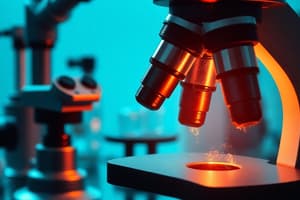Podcast
Questions and Answers
Identify the parts of a microscope to match with their descriptions:
Identify the parts of a microscope to match with their descriptions:
Eyepiece(s) = Ocular lens or lenses Body tube = Connects eyepiece to objective lenses Nosepiece = Holds objective lenses Stage = Platform to hold slides Diaphragm = Controls the amount of light Condenser = Focuses light on the specimen Fine-adjustment knob = Used for fine focusing Coarse-adjustment knob = Used for initial focusing
What is the magnifying power of the ocular lenses on your microscope?
What is the magnifying power of the ocular lenses on your microscope?
10x
What is the magnifying power of the scanning lens on your microscope?
What is the magnifying power of the scanning lens on your microscope?
4x
What is the magnifying power of the low-power objective lens on your microscope?
What is the magnifying power of the low-power objective lens on your microscope?
What is the magnifying power of the high-power objective lens on your microscope?
What is the magnifying power of the high-power objective lens on your microscope?
What does the letter e look like on a slide with the unaided eye?
What does the letter e look like on a slide with the unaided eye?
What does the letter e look like when viewed through the eyepiece?
What does the letter e look like when viewed through the eyepiece?
When you move the slide to the right, which way does the image appear to move?
When you move the slide to the right, which way does the image appear to move?
Which microscope has the best surface visibility of an object?
Which microscope has the best surface visibility of an object?
The resolving power of a light microscope is equal to that of an electron microscope.
The resolving power of a light microscope is equal to that of an electron microscope.
What does compound refer to in the designation compound light microscope?
What does compound refer to in the designation compound light microscope?
What unit of metric measurement is most useful for light microscopy?
What unit of metric measurement is most useful for light microscopy?
Which part of the microscope controls the amount of light?
Which part of the microscope controls the amount of light?
What is the adjustment knob used with high power?
What is the adjustment knob used with high power?
What is the final item placed on a wet mount before viewing with a light microscope?
What is the final item placed on a wet mount before viewing with a light microscope?
Which objective always should be in place when beginning to use the microscope?
Which objective always should be in place when beginning to use the microscope?
If Euglena are swimming to the left, which way should you move your slide to keep them in view?
If Euglena are swimming to the left, which way should you move your slide to keep them in view?
Study Notes
Microscope Parts and Functionality
- Key components of a microscope include eyepieces, body tube, nosepiece, objective lenses, stage, diaphragm, and light source.
- Eyepiece typically has a magnifying power of 10x.
- Scanning objective lens usually offers a magnification of 4x, low-power objective lens 10x, and high-power objective lens 40x.
Observing and Imaging
- When viewed unaided, the letter "e" appears in its normal orientation, but appears upside down and reversed when viewed through the eyepiece.
- Movement of the slide in the microscope causes the image to move in the opposite direction; for example, moving right shows the image moving left.
Magnification and Measurement
- Total magnification can be calculated by multiplying the ocular and objective lens powers:
- Scanning: 10x (ocular) x 4x (objective) = 40x
- Low power: 10x x 10x = 100x
- High power: 10x x 40x = 400x
- A common measurement for microscopy is micrometers (1 mm = 1000 µm).
Field of View
- Low power allows for a larger field of view, making it easier to locate small objects.
- High power provides greater magnification but with a smaller field of view.
Preparing and Using Microscopes
- Start locating small objects under low power before switching to high power for detailed observation.
- The diaphragm controls light intensity, and the lower power objective should be used when beginning or ending use of the microscope.
- Parfocal means that if an object is in focus at low power, it will remain in focus when switching to high power.
Microscope Types
- The scanning electron microscope is best for revealing an object's surface.
- A compound light microscope is ideal for observing live organisms such as Euglena swimming in pond water.
Care and Handling
- Always conclude with the coverslip when preparing a wet mount.
- Fine adjustment knob is essential when using high power to achieve clarity.
- When observing movement (e.g., Euglena), move the slide in the opposite direction to keep the specimen in view.
Study Specifics
- When layers of threads are layered from red to green, the green layer comes into focus first under proper use of the microscope.
- For viewing whole, opaque objects, a stereomicroscope is employed.
Studying That Suits You
Use AI to generate personalized quizzes and flashcards to suit your learning preferences.
Description
Test your knowledge on the components of light microscopy with these flashcards. Identify and label various parts of a microscope, including the eyepiece, objective lens, and more. Perfect for students studying biology or related fields.




